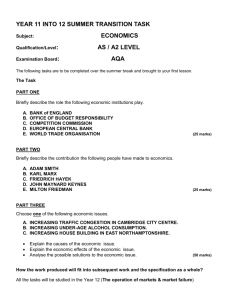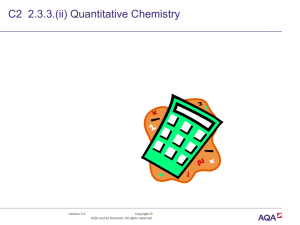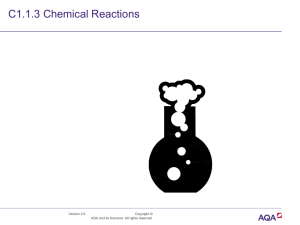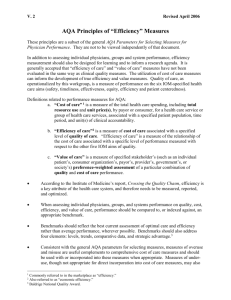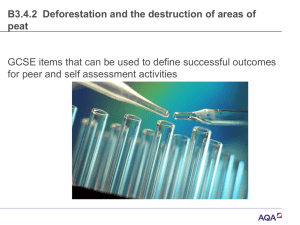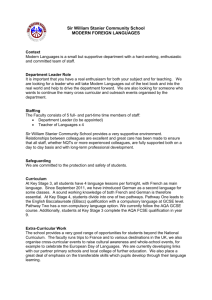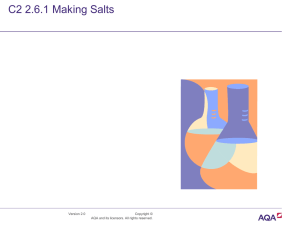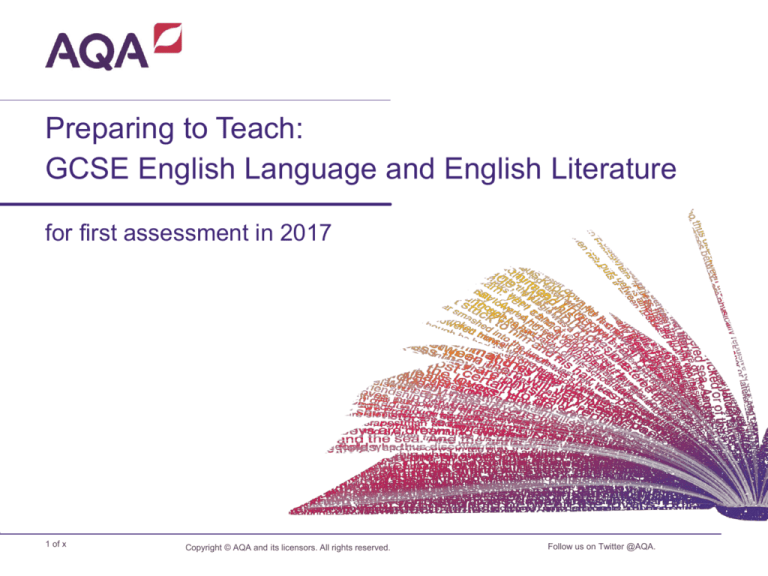
Preparing to Teach:
GCSE English Language and English Literature
for first assessment in 2017
1 of x
Copyright © AQA and its licensors. All rights reserved.
Follow us on Twitter @AQA.
Something for every learner
Progression Strand 1:
KS3 Curriculum
GCSE
AS and A level
KS3 resources
KS3 assessment papers
KS4 resources
Sample papers
Marker training
e-Library
KS5 resources
Sample papers
Step Up
to English
GCSE/Post 16 literacy
e-Library
Progression Strand 2:
KS3 Curriculum
2 of x
Copyright © AQA and its licensors. All rights reserved.
How this session will work
•
Self-reference materials support preparation for teaching familiar skills and
question formats that have a degree of continuity and familiarity.
•
Time for brief reflection and discussion.
•
Where our revised assessments have a new emphasis or approach:
•
•
•
3 of x
we look in detail at these
explore the mark scheme
try out approaches to teaching and learning.
Copyright © AQA and its licensors. All rights reserved.
Preparing to teach:
GCSE English Language
4 of x
Copyright © AQA and its licensors. All rights reserved.
Follow us on Twitter @AQA.
English Language specification at a glance
5 of x
Copyright © AQA and its licensors. All rights reserved.
Assessment Objective 1
Assessment Objective
•
Identify and interpret explicit and implicit information and ideas.
•
Select and synthesise evidence from different texts.
6 of x
Copyright © AQA and its licensors. All rights reserved.
Assessment Objective 2
Assessment Objective
• Explain, comment on and analyse how writers use language
and structure to achieve effects and influence readers, using
relevant subject terminology to support their views.
7 of x
Copyright © AQA and its licensors. All rights reserved.
Assessment Objective 3
Assessment Objective
• Compare writers’ ideas and perspectives, as well as how
these are conveyed, across two or more texts.
8 of x
Copyright © AQA and its licensors. All rights reserved.
Assessment Objective 4
Assessment Objective
• Evaluate texts critically and support this with appropriate
textual references.
9 of x
Copyright © AQA and its licensors. All rights reserved.
Assessment Objective 5 and 6
Assessment Objectives
AO5
• Communicate clearly, effectively and imaginatively, selecting
and adapting tone, style and register for different forms,
purposes and audiences.
• Organise information and ideas, using structural and
grammatical features to support coherence and cohesion of
texts.
AO6
• Use a range of vocabulary and sentence structures for clarity,
purpose and effect, with accurate spelling and punctuation.
10
of 12
x
Slide
Copyright © AQA and its licensors. All rights reserved.
11 of x
Self-reference pack
Look at the Resource booklet.
Opportunity for brief review and answering of questions.
This pack covers:
•
•
•
•
•
Paper 1 Q1
Paper 1 Q2
Paper 2 Q1
Paper 2 Q3
Paper 2 Q5.
Note: Use of notional reading time at the start of each paper.
12 of x
What is new?
Our main focus today will be on starting points and approaches to:
•
•
Paper 1 Q3, Q4, Q5
Paper 2 Q2, Q4.
13 of x
Paper 1 Q3: AO2 (Structure)
You now need to think about the whole of the text.
This text is from the opening of a novel.
How has the writer structured the text to interest you as a reader?
You could write about:
•
•
•
14 of x
what the writer focuses your attention on at the beginning
how and why the writer changes the focus as the extract develops
any other structural features that interest you.
A reminder about AO2
AO2 sets out an internal hierarchy of progression:
•
•
•
explain
comment (on)
analyse.
See mark scheme: As with P1 Q2, this rewards the skill of analysis at level 4.
15 of x
Thinking about a ladder of skills progression:
Level of response 3
The mark scheme asks:
To see some accurate subject terminology
(relating to structure)
To see relevant exemplification
(textual reference)
To have a clear explanation of the effects of some of the structural features
(effect and impact)
All of which will lead to a demonstration of:
A clear understanding of structural features.
16 of x
What is structure?
•
How authors internally organise a text.
•
“As authors write a text to communicate an idea, they will use a structure that
goes along with the idea.”
Meyer 1985
17 of x
What can the structure of a text reveal?
•
•
•
•
•
The (narrative) perspective of the text (what?)
The organisation and use of time (when?)
The location and setting (where?)
Characters and how they are introduced (who?)
The different patterns within the text, and elements of syntax or cohesion that
help to create (reinforce) meaning (how?)
18 of x
For our students this might translate to …
Whose views?
Who is telling the story? What perspective is it from?
What time is it?
How is time ordered in it? What sort of sequence do I see?
Where am I?
What’s the place, location, setting? How did I find out?
Who is here?
What character(s) have I met and how were they introduced?
What’s it made of?
What shapes, styles and patterns can I see in the sentences?
19 of x
1
2
3
4
5
An activity:
•
Taking the source from Brighton Rock in your new specimen paper, work
together to complete a Structure Jigsaw Puzzle.
•
You have 10 minutes!
20 of x
One teacher’s approach to teaching structure
•
21 of x
A video is available on the AQA website to show how a teacher does this in
the classroom.
Paper 1 Q4: AO4 (Critical evaluation)
For this question you need to focus on the second part of the text only, from
line 16 to the end.
A student, having read this section of the text, said: “This part of the text,
explaining what Hale is doing, shows how nervous and unsafe he feels. It
reminds me of the first line.”
To what extent do you agree?
In your response, you could:
• consider your own impressions of how Hale feels
• evaluate how the writer creates an unsafe atmosphere
• support your own opinions with quotations from the text.
22 of x
Being critical and evaluative
The question itself is a culmination of the ‘footprint’ of skills: AO1
AO2
AO4
The key for students is to:
•
•
•
have a sense of their own response
develop the ability to ask questions independently about texts to enable them
to interrogate, contest and have a response to what they read
use the statement in the question to help inform their interpretation and
evaluation of it.
23 of x
Thinking Prompts: What?
Idea 1: He seems
to be in a rush. He
wants to get out of
the bar and keep
moving
Idea 2: He
seems
compelled to do
his job. Dutiful
but feels
vulnerable in
Brighton
24 of x
What am I
agreeing with?
- Nervous
- Unsafe
‘Hale knew
…that they
meant to murder
him?’
Idea 3: He
wants to be
found quickly
by a member
of the public
Thinking Prompts: How?
Idea 1:
Idea 2:
25 of x
How does the
writer make use
of that first line?
- ‘Hale knew
…that they
meant to murder
him.’
Idea 3:
Thinking Prompts: What and How
What?
How?
•
•
•
•
He seems to be in a rush. He
wants to get out of the bar and
keep moving.
He seems compelled to do his
job. Dutiful but feels vulnerable in
Brighton.
He wants to be found quickly by
a member of the public. He
seems to be hiding in plain sight
but seems tense and conscious
of the underlying threat
potentially lurking in the crowd.
26 of x
•
•
Writer uses time references ‘clock
struck eleven’ and adverb ‘hastily’.
Repetition of ‘always on time’
‘always’ ‘always’.
The reference to the ‘Whitsun
crowd’, the hint from ‘his
inclination’, the irony of the
references to
‘challenge/challenger’, the insidious
description of the crowd as a
‘twisted piece of wire’.
P1 Q4 mark scheme: Content description
See the skills and then content descriptors for successive levels of response.
How the content descriptors are designed to function:
•
•
•
27 of x
not as model answers
not as exhaustive or complete responses
but as an indication of the type of level of response.
One teacher’s approach to teaching critical reading skills
•
28 of x
A video is available on the AQA website to show how a teacher does this in
the classroom.
Paper 1 Q5
•
Always a choice of written prompt and visual image that is linked to the
topic of the reading text in section A.
•
Always a creative task focusing on narrative and, or descriptive writing
skills: one narration and one description, or two description, or two
narration.
•
Marks for content and organisation as well as for technical accuracy.
•
Mark scheme designed to encourage ambition.
•
Section B will be allocated 40 marks to give an equal weighting to the
reading and writing tasks.
29 of x
Paper 2 Q2: AO1 and Q4: AO3
Paper 2 Q2 tests AO1 skills using two texts. To be successful at the top level of the
MS, students need to:
•
•
•
select a judicious range of textual detail – connected to the focus of the
question
synthesise the detail from both texts, in order to…
provide a perceptive interpretation.
A ‘stepping stone’ to Paper 2 Q4 which tests AO3 comparison. Students need to
additionally:
•
•
compare how ideas are conveyed
analyse the methods used.
30 of x
Paper 2 Q2: AO1 (synthesis)
You need to refer to source A and source B for this question.
The things to see and do at Glastonbury Festival and Greenwich Fair are
different.
Use details from both sources to write a summary of the differences.
31 of x
The mark scheme: Level of response 3
•
•
•
Demonstrates clear connections between texts.
Selects relevant quotations from both texts to support summary.
Begins to interpret both texts.
This leads to:
Showing a clear understanding of the differences.
32 of x
The S.Q.I method
Text mark or list details from both texts – to cover the requirement for details
(in this question about different things to see and do). Then:
•
•
•
33 of x
Make clear statements about the connections (in this case differences)
Quote details
Make an inference from the quotation which shows understanding.
Details: Different things to see and do
Glastonbury Festival:
Greenwich Fair:
‘In one field, a series of tents has lost
its moorings’
‘half a pound of the real spice nuts’,
‘The acts for 2005 included Coldplay
….. The Killers,’
‘you have a melodrama … a
pantomime, a comic song …’
34 of x
‘pennyworths of pickled salmon’
Adding statements
Glastonbury Festival
Greenwich Fair
S: You can camp out
Q: ‘In one field, a series of tents has
lost its moorings’
S: You can buy a selection of food
Q: ‘half a pound of the real spice nuts’,
‘pennyworths of pickled salmon’
S: You can see bands play
Q: ‘The acts for 2005 included
Coldplay ….. The Killers,’
S: You can watch some theatrical
performances
Q: ‘you have a melodrama … a
pantomime, a comic song …’
35 of x
Put them together in summary
Both Glastonbury and Greenwich have a focus on outdoor fun, but whereas
modern crowds can camp out at Glastonbury in ‘a series of tents …’ which could
be chaotic because “some lose their moorings” and go there to see bands like
“Coldplay and The Killers”, at Greenwich the crowd went for treats to eat like
“spice nuts” and “pennyworths of pickled salmon”. This suggests people have
more leisure time to spend at Glastonbury than the crowd at Greenwich who
seem to be enjoying a rare day out…
36 of x
Paper 2 Q4: AO3 (comparison)
For this question you need to refer to the whole of source A together with the
whole of source B.
Compare how the writers have conveyed their different views and experiences
of the festival and fair they describe.
In your answer, you could:
•
•
•
37 of x
compare their different experiences
compare the methods they use to convey those experiences
support your ideas with quotations from both texts.
How do you teach comparison?
Look at the levels of response mark scheme, in particular, the content
description:
•
•
How do you currently teach comparison skills?
Share successful approaches with colleagues on your tables.
38 of x
Preparing to teach:
GCSE English Literature
39 of x
Copyright © AQA and its licensors. All rights reserved.
Follow us on Twitter @AQA.
An opportunity to explore in more detail:
•
•
•
•
40 of x
an overview of both papers
the importance of extract-to-whole assessment (Paper 1 Sections A and B)
textual “references” and assessment of AO1 and AO2 in closed-book
conditions
comparison of seen (Paper 2 Section B) and unseen (Paper 2 Section C)
poetry.
English Literature specification at a glance
41 of x
Copyright © AQA and its licensors. All rights reserved.
English Literature specification
42 of x
Copyright © AQA and its licensors. All rights reserved.
Assessment Objective 1
AO1
GCSE English Literature
Assessment Objective
Read, understand and
respond to texts
What this means
Students should be able
to:
The student’s response to the text –
the extent to which they understand
the text and its meaning(s) to them
as reader
37.5%
maintain a critical
style and develop
an informed
personal response
use textual
references,
including
quotations, to
support and
illustrate
interpretations
43 of x
This AO focuses on two areas of
‘response’:
The student’s response to the task –
the extent to which they produce a
coherent response, supported with
references to the text
Copyright © AQA and its licensors. All rights reserved.
Assessment Objective 2
AO2
Analyse the language,
form and structure used
42.5% by a writer to create
meanings and effects,
using relevant subject
terminology where
appropriate
44 of x
This AO focuses on writer’s craft:
how the writer has communicated
meanings to the reader.
Ideally students will use subject
terminology as a ‘shorthand’ to
scaffold their analysis of craft.
Copyright © AQA and its licensors. All rights reserved.
Assessment Objective 3
AO3 Show understanding of
the relationships between
15% texts and the contexts in
which they were written
AO3 is the understanding of the
relationship between the ideas in the
text and the contexts of the text,
such as:
the context in which the text
was written
the context within which the
text is set (location / social
structures and features /
cultural contexts / periods in
time)
literary contexts such as
genres
the contexts in which texts are
engaged with by different
audiences
45 of x
Copyright © AQA and its licensors. All rights reserved.
Assessment Objective 4
AO4 Use a range of
vocabulary and sentence
structures for clarity,
purpose and effect, with
accurate spelling and
punctuation
46 of x
This AO focuses on the student’s
use of SPaG to communicate ideas
to the reader.
Copyright © AQA and its licensors. All rights reserved.
Comparison
“In each specification as a whole, 20-25% of the marks should require
candidates to show the abilities described in AO1, AO2 and AO3
through tasks which require them to make comparisons across texts.”
47 of x
Copyright © AQA and its licensors. All rights reserved.
Defining Context (AO3)
AO3 is the understanding of the relationship between the ideas in the text and
the contexts of the text.
The range of contexts and relationships that is most relevant as part of AO3 will
depend on the text, the author and the task.
In teaching and assessing AO3, teachers and students can consider context in a
flexible way, dependent on the text itself and whichever contexts are the most
relevant for that particular text.
These contexts may relate to the relationship between the text and the context in
which it was written.
However, these contexts may also relate to the context within which the text is set:
location, social structures and features, cultural contexts, and periods in time.
Context, where relevant, may also apply to literary contexts such as genres.
It may also apply to the contexts in which texts are engaged with by different
audiences.
48 of x
Context in questions
•
Starting with this speech, explain how far you think Shakespeare presents
Macbeth as a hero.
•
At the start of Lord of the Flies, Piggy asks Ralph: ‘Aren’t there any grownups at all?’ How does Golding present ideas about being a ‘grown-up’ in
Lord of the Flies?
49 of x
Paper 1: Extract to whole assessment
50 of x
A holistic response to Paper 1 assessments
Candidates can:
•
•
•
•
spend more time on the extract
or, spend more time on the whole
write about the extract and then the whole
approach both together at the same time.
The response is marked as a whole. There is not a separate mark allocation
for either of the two bullet points.
51 of x
A Skills Hierarchy:
Level
Descriptor
6
•
•
•
Critical, exploratory, well-structured approach to task and whole text
Conceptualised approach supported by judicious references from text
Insightful analysis of language, structure and form
5
•
•
•
Thoughtful, developed consideration of task and whole text
References from text integrated into interpretation
Detailed examination of effects of writer’s methods
4
•
•
•
Clear, sustained understanding of task and whole text
References from text used to support explanation
Clear explanation of effects of range of writer’s methods
3
•
•
•
Explained response to task and whole text
Supported by range of relevant references to text
Identification of effects of range of writer’s methods
2
•
•
•
Supported, relevant comments on task and text
Relevant references to text
Identification of writer’s methods
1
•
•
•
Simple, explicit comments showing awareness of task and text
Narrative / descriptive references to text
Awareness of writer making choices
52 of x
One way of approaching an extract
To engage students in similar ways to how they might approach extracts in the
GCSE English Language papers:
•
•
•
•
•
53 of x
what are the main ideas , themes or character that is being introduced, or
developed?
how do particular choices of words/phrases/ or lines within the extract
affect the reader?
why is the writer seeking to have this effect at this particular point in the
play or novel?
what other parts, or key pivotal moments of the text does it suggest?
when I read this, what do I think is important? How does it add to, reinforce
or change how I think about the character, relationships, themes or ideas
that I have been studying?
One way of approaching an extract
Read the following extract from Act 3 Scene 2 of Romeo and Juliet and then
answer the question that follows.
At this point in the play Juliet is waiting for the Nurse to come back from meeting
Romeo.
Starting with this speech, explore how Shakespeare uses language to present
attitudes towards love in Romeo and Juliet.
Write about:
•
•
54 of x
what Juliet says about love in this speech
how Shakespeare uses language to present
attitudes to love in the play as a whole.
Romeo and Juliet extract
JULIET
Come, night; come, Romeo; come, thou day in night;
For thou wilt lie upon the wings of night
Whiter than new snow on a raven's back.
Come, gentle night, come, loving, black-brow'd night,
Give me my Romeo; and, when he shall die,
Take him and cut him out in little stars,
And he will make the face of heaven so fine
That all the world will be in love with night
And pay no worship to the garish sun.
O, I have bought the mansion of a love,
But not possess'd it, and, though I am sold,
Not yet enjoy'd: so tedious is this day
As is the night before some festival
To an impatient child that hath new robes
And may not wear them. O, here comes my nurse,
And she brings news; and every tongue that speaks
But Romeo's name speaks heavenly eloquence.
55 of x
Romeo and Juliet extract
JULIET
Come, night; come, Romeo; come, thou day in night;
For thou wilt lie upon the wings of night
Whiter than new snow on a raven's back.
Come, gentle night, come, loving, black-brow'd night,
Give me my Romeo; and, when he shall die,
Take him and cut him out in little stars,
And he will make the face of heaven so fine
That all the world will be in love with night
And pay no worship to the garish sun.
O, I have bought the mansion of a love,
But not possess'd it, and, though I am sold,
Not yet enjoy'd: so tedious is this day
As is the night before some festival
To an impatient child that hath new robes
And may not wear them. O, here comes my nurse,
And she brings news; and every tongue that speaks
But Romeo's name speaks heavenly eloquence.
56 of x
One teacher’s approach to teaching extract to whole
assessment
•
57 of x
A video is available on the AQA website to show how a teacher does this in
the classroom.
Paper 2
Section A
58 of x
Approaches to textual references
and assessment of AO1/AO2 in
closed-book conditions…
Paper 2 Section A
How does Priestley present some of the differences between the older and
younger generations in An Inspector Calls?
Write about:
• how the different generations respond to events and to each other
• how Priestley presents the different generations in the play.
Activity:
Use the mark scheme to rank order the two responses:
•
•
which makes more useful references to the text?
which response shows that the candidate has better engagement with the
question, and text?
59 of x
A Skills Hierarchy
Level
Descriptor
6
•
•
•
Critical, exploratory, well-structured approach to task and whole text
Conceptualised approach supported by judicious references from text
Insightful analysis of language, structure and form
5
•
•
•
Thoughtful, developed consideration of task and whole text
References from text integrated into interpretation
Detailed examination of effects of writer’s methods
4
•
•
•
Clear, sustained understanding of task and whole text
References from text used to support explanation
Clear explanation of effects of range of writer’s methods
3
•
•
•
Explained response to task and whole text
Supported by range of relevant references to text
Identification of effects of range of writer’s methods
2
•
•
•
Supported, relevant comments on task and text
Relevant references to text
Identification of writer’s methods
1
•
•
•
Simple, explicit comments showing awareness of task and text
Narrative / descriptive references to text
Awareness of writer making choices
60 of x
An Inspector Calls sample responses
Priestley shows lots of differences between the older and younger generations in An
Inspector Calls. At the start of the play Mr Birling spends a lot of time saying what he
thinks and giving advice. He says: ‘there is a lot of silly talk about these days’ about
the war. He also says that ‘we’ve passed the worst of it’. This shows that he isn’t right
because the war happened, so Priestley is showing that Mr Birling isn’t going to be
right about anything. He then gives another long speech to Eric and Gerald. He says;
‘you’ve a lot to learn yet.’ This makes him sound as if he thinks he’s better than Eric
and Gerald. He also says that he is a ‘hard-headed man of business’. Then he says; ‘a
man has to mind his own business and look after himself and his own’. His famous
quote is about the Titanic where he says ‘unsinkable, absolutely unsinkable’. At the
end of the play he says ‘the whole story’s just a lot of moonshine’. He also says ‘the
famous younger generation who know it all. And they can’t even take a joke.’
Mrs Birling is the same because she tries to say that Eric and Sheila are just tired at
the end of the play as if they are just children. ‘They’re over-tired’.
Sheila and Eric are different because they learn things from the Inspector. Eric learns
because he says ‘we helped to kill her’ and Sheila says ‘I suppose we’re all nice
people now’.
61 of x
An Inspector Calls sample responses
In An Inspector Calls, Priestley uses the contrast between the younger and older
generations to explore his ideas about society and responsibility. As the play
progresses, the contrast gets more extreme. At the start of the play, Eric is shown to
be irresponsible through the presentation of him as a drinker. Sheila is getting
engaged and is shown to be very excited about her engagement ring, although
Priestley uses stage directions to hint that there is a more serious side to her ‘half
serious, half playful’. Because of what we later find out about Gerald and his similarity
to Mr Birling, this direction shows that Sheila is quite wise and has good instincts.
On the other hand Mr Birling is shown to have very bad instincts in Act One. He keeps
telling the ‘youngsters’ to listen to him, as if he is drawing attention to the wisdom of
his years and experience. This repetition forces the audience to pay attention to the
differences between the older and younger generations, as if Priestley is indicating
that this is an important idea in the play. This is then highlighted even further with Mr
Birling’s confident statements about the Titanic and the War: ‘unsinkable, absolutely
unsinkable’ and ‘The Germans don’t want war’. These statements in particular allow
Priestley to demonstrate the arrogance of people like Birling who think they know it all
but are completely wrong. The language Birling uses is blunt and to the point, as if
there is no room for argument in what he thinks. However, Priestley is using irony here
to show how wrong he is and therefore not to be trusted, in contrast with Sheila who
has very good instincts.
62 of x
An Inspector Calls sample responses
In An Inspector Calls, Priestley uses the contrast between the younger and older
generations to explore his ideas about society and responsibility. As the play
progresses, the contrast gets more extreme. At the start of the play, Eric is shown to
be irresponsible through the presentation of him as a drinker. Sheila is getting
engaged and is shown to be very excited about her engagement ring, although
Priestley uses stage directions to hint that there is a more serious side to her ‘half
serious, half playful’. Because of what we later find out about Gerald and his similarity
to Mr Birling, this direction shows that Sheila is quite wise and has good instincts.
On the other hand Mr Birling is shown to have very bad instincts in Act One. He keeps
telling the ‘youngsters’ to listen to him, as if he is drawing attention to the wisdom of
his years and experience. This repetition forces the audience to pay attention to the
differences between the older and younger generations, as if Priestley is indicating
that this is an important idea in the play. This is then highlighted even further with Mr
Birling’s confident statements about the Titanic and the War: ‘unsinkable, absolutely
unsinkable’ and ‘The Germans don’t want war’. These statements in particular allow
Priestley to demonstrate the arrogance of people like Birling who think they know it all
but are completely wrong. The language Birling uses is blunt and to the point, as if
there is no room for argument in what he thinks. However, Priestley is using irony here
to show how wrong he is and therefore not to be trusted, in contrast with Sheila who
has very good instincts.
63 of x
The English e-Library
Because English is so much more than words on paper.
•
•
•
•
•
•
64 of x
Allows your students to interact with texts in new
and exciting ways.
Packed with bespoke audio, video and image
content, lesson plans and teaching ideas.
Customisable resources - highlight texts, search for
keywords, add and save annotations, link
resources and add weblinks, share with individuals
and groups.
Authoritative content created for teachers, by
teachers.
Video clips can be used on and offline to introduce
lessons, as homework, or as models for students to
create their own content.
Available exclusively and free of charge to those to
commit to teaching with us.
Copyright © AQA and its licensors. All rights reserved.
Paper 2 Section B: Comparison of studied poems
To help, we:
•
•
list the titles of poems in each cluster on the exam paper as a key reminder
print the poem named in the question on the exam paper.
Students need to:
•
•
know their chosen cluster of poems holistically
be able to make connections and comparisons between the poems and the
theme of the cluster.
Students will need help to:
•
•
•
use the named poem for close AO2 references in particular
focus on the named poem printed for them in the question paper as a starting
point
consider how best to reference their own choice of poem for the purpose of
comparison.
65 of x
Activity
1. Look at this question from the first set of specimen papers:
Compare the ways poets present ideas about power in ‘Ozymandias’ and in
one other poem from ‘Power and conflict’.
2. How is this student making effective references to the poems? See response
in your pack.
3. Now look briefly at the questions in the second set of specimen papers: How
are they establishing a similar degree of support for students to address AO1
and AO2?
66 of x
Activity
Both ‘Ozymandias’ and ‘My Last Duchess’ show the effects of power and how it corrupts. Shelley
describes Ozymandias’ ‘sneer of cold command’ as if to suggest that he is a cruel and heartless leader,
only concerned with his own power and the immortality it will bring. The Duke in ‘My Last Duchess’ is
similarly concerned with his own power and status . Although the monologue is supposed to replicate a
conversation, there is no opportunity for his listener to speak – Browning writes the monologue to show
the Duke’s self-obsession and that he is not interested in anyone’s views other than his own.
Ozymandias might have had ‘cold command’ of his ‘lands’, just like the Duke ‘gave commands’. Both
poets are concerned with the effects of power and how in the wrong hands it corrupts. The Duke is
shown to be misguided as Browning uses imagery to hint at the Duchess’ kindness and gentle spirit
(white pony) to prove that she is innocent and has been killed for nothing. Ozymandias is shown to also
be cruel: ‘sneer of cold command’ – however he has been left with nothing: ‘the lone and level sands
stretch far away’. It could be argued that the Duke has also been left with nothing: he has a statue of
‘Neptune’ which is made of cold bronze. He doesn’t realise this himself however, as he cares nothing for
human relationships and is far more concerned, like Ozymandias, with his pride and reputation.
Ultimately both leaders are shown by the poets to be corrupt. Both poets feel that power in the wrong
hands has devastating consequences on the innocent. However, although both poets show that this
corruption is punished in the end, perhaps it is the Duke who is shown more clearly to be the true despot
as Browning uses the dramatic monologue to show first hand how completely self absorbed he is.
67 of x
Paper 2 Section C: Comparison of unseen poetry
Students do really well, and seem to enjoy, responding to unseen poems.
The response to unseen is the final task. In this way, it gives students the
opportunity to demonstrate and use the skills they have learned throughout the
course in a ‘synoptic’ way.
Comparison of unseen texts is a requirement of the qualification. However, this
element of the qualification is worth 8 marks out of a total of 168.
As students respond to the first unseen poem, they are mentally gathering ideas
to use in the final 8 mark task.
Both poems will have very clear links and connections in terms of ideas.
The final 8 mark task will also make these main links and connections explicit.
68 of x
Paper 2 Section C: Comparison of unseen poetry
How to Leave the World that Worships Should
Let faxes butter-curl on dusty shelves.
Let junkmail build its castles in the hush
of other people’s halls. Let deadlines burst
and flash like glorious fireworks somewhere else.
As hours go softly by, let others curse
the roads where distant drivers queue like sheep.
Let e-mails fly like panicked, tiny birds.
Let phones, unanswered, ring themselves to sleep.
Above, the sky unrolls its telegram,
immense and wordless, simply understood:
you’ve made your mark like birdtracks in the sand now make the air in your lungs your livelihood.
See how each wave arrives at last to heave
itself upon the beach and vanish. Breathe.
Ros Barber
69 of x
Sample Task
27.1
In ‘How to Leave the World that Worships Should,’ how does the poet present
ideas about the way we live and work in the modern world?
70 of x
Activity
•
Read the question and the poem.
•
Select three lines / words / phrases that you think are particularly
significant.
71 of x
Paper 2 Section C: Comparison of unseen poetry
The Rich Eat Three Full Meals
The rich eat three full meals, the poor two small bowls
But peace is what matters.
Thirsty, I drink sweet plum tea;
Warm, I lie in the shade, in the breeze;
My paintings are mountains and rivers all around me,
My damask*, embroidered, the grass.
I rest at night, rest easy,
Am awake with the sun
And enjoying Heaven’s heaped-up favours.
Nguyen Binh Khiem
72 of x
Paper 2 Section C: Comparison of unseen poetry
27.2
In both ‘The Rich Eat Three Full Meals’ and ‘How to Leave the World that
Worships Should’, the speakers describe attitudes towards the world around
us. What are the similarities and / or differences between the ways the poets
present these attitudes?
73 of x
Forming a comparative response
Both….
Both….
However….
74 of x
Paper 2 Section C top level three response…?
Both speakers are talking about how it is important to enjoy life and see the beauty of
the natural world. In ‘The Rich…’ the poet uses positive images to show the beauty of
the world for example ‘my paintings are mountains and rivers’ which gives the sense
that he sees the world as a work of art and something precious to be admired. In ‘How
to’, the poet also uses positive imagery although she uses them to show the power and
size of the natural world such as ‘immense and wordless’, as if the natural world is
bigger and much more important than the human world. This suggests that Barber
sees the natural world as something bigger that we can’t own, but the poet in ‘The Rich’
seems to suggest something different through his images, as if the natural world
belongs to humans. This is also suggested by the ways both poets position the idea of
‘peace’. In ‘The Rich’ it is on the second line but Barber puts the word ‘breathe’ right at
the end of the poem.
Both suggest that it is the main point of their poem however, because in ‘The Rich’ it is
a definite statement: ‘peace is what matters’ and in ‘How To’ it is a direct instruction in a
single word sentence at the end of the poem.
However, although both poems are about similar ideas, ‘How to’ seems more direct and
as if it matters more. She uses second person and lots of instructions to the reader in
the second verse, whereas ‘The Rich’ just describes his own way of looking at the
world. This makes ‘How to’ seem more powerful and direct as if it is very important that
we do as she says.
75 of x
Co-teaching our specifications
76 of x
Copyright © AQA and its licensors. All rights reserved.
Co-teachable skills
AO
Skills
Planning Opportunities
Lang AO1
Lit
AO1
Having a response to what
they read
Lang 1 Sec A
Lit
1 Sec A, B
Lit
2 Sec A
Lang AO2
Lit
AO2
Being able to analyse
language and textual
references
Lang 1 Sec A
Lit
1 Sec A, B
Lit
2 Sec A, B, C
Lang AO4
Lit
AO1
Developing a more critical
response
Lang 1 Sec A
Lit
1 Sec A, B
Lit
2 Sec A, B, C
Lang AO3
Lit
AO2
Being able to compare ideas
and texts
Lang 2 Sec A
Lit
2 Sec B, C
77 of x
Copyright © AQA and its licensors. All rights reserved.
Plenary activity
Consider how you might co-teach for language and literature skills
development:
• close reading responses to an extract
• critical interpretations
• use of a literature set text to give coherence
(and content) within a unified course.
78 of x
Copyright © AQA and its licensors. All rights reserved.
Further support from AQA
•
GCSE English subject team: english-gcse@aqa.org.uk / 0161 953 7504
• One hour video presentations of the new GCSE English Language and
Literature can be accessed via the AQA website:
http://www.aqa.org.uk/subjects/english/gcse/english-language-specificationlaunch-webcast
http://www.aqa.org.uk/subjects/english/gcse/english-literature-specificationlaunch-webcast
• Resources on website for GCSE English Language and English Literature:
• planning resources
• teaching resources
• assessment resources.
• Further training courses will be available from autumn 2015 details can be
found on the AQA website: www.aqa.org.uk/professional-development
79 of x
Copyright © AQA and its licensors. All rights reserved.
NEW! Exampro English
•
Free for a limited time
•
See real student responses to exam
questions, highlighted and
annotated
•
Get insight into assessment
objectives and standards for GCSE
English
•
Great for
CPD
Whiteboard plenaries
Mock exams and progress tests
"Taking the mystery out of marking, it
provides reliable information direct from
the exam board!“
Register today for free
exampro.co.uk/english
80 of x
80
Copyright © AQA and its licensors. All rights reserved.
Caroline Woolfe, English teacher
Commit to teach AQA English specifications
•
81 of x
If you complete a Commit to teach you will have access to further resources
from AQA.
Copyright © AQA and its licensors. All rights reserved.
Thank you
We are an independent education charity
and the largest provider of academic qualifications for all abilities
taught in schools and colleges.
Our aim is to enable students to realise their potential
and provide teachers with the support and resources they need
so that they can focus on inspiring learning.
http://www.aqa.org.uk/
82 of x
Follow us on Twitter @AQACPD.
Copyright © AQA and its licensors. All rights reserved.

